 I used to play the Tuba in the Kiltie band way back in college at Carnegie Mellon, so I have an eye for tuba player pictures wherever I go. This picture is by Howard Pyle and is hanging in the Delaware Art Museum.
I used to play the Tuba in the Kiltie band way back in college at Carnegie Mellon, so I have an eye for tuba player pictures wherever I go. This picture is by Howard Pyle and is hanging in the Delaware Art Museum.tags: art, museum, tuba
In which the author ponders the question, "If you admit that you are a hypocrite, are you really a hypocrite?" He then provides his honest commentary on a number of fascinating topics. He insists, however, that his readers form their own opinions.
 I used to play the Tuba in the Kiltie band way back in college at Carnegie Mellon, so I have an eye for tuba player pictures wherever I go. This picture is by Howard Pyle and is hanging in the Delaware Art Museum.
I used to play the Tuba in the Kiltie band way back in college at Carnegie Mellon, so I have an eye for tuba player pictures wherever I go. This picture is by Howard Pyle and is hanging in the Delaware Art Museum. Actually this work is called Peace Through Chemistry IV by Roy Lichtenstein. How could I, a chemical engineer, pass up taking a photograph of this one to share with you. Roy Lichtenstein is a pop artist whose most famous works, you might remember, remind one of comic strips.
Actually this work is called Peace Through Chemistry IV by Roy Lichtenstein. How could I, a chemical engineer, pass up taking a photograph of this one to share with you. Roy Lichtenstein is a pop artist whose most famous works, you might remember, remind one of comic strips. This haunting picture of the Flying Dutchman at the Delaware Art Museum was painted by Howard Pyle, a renowned illustrator, in 1900. Howard Pyle was a native of Wilmington, Delaware and taught a number of artists of the Brandywine school, N.C. Wyeth, Maxfield Parrish and others.
This haunting picture of the Flying Dutchman at the Delaware Art Museum was painted by Howard Pyle, a renowned illustrator, in 1900. Howard Pyle was a native of Wilmington, Delaware and taught a number of artists of the Brandywine school, N.C. Wyeth, Maxfield Parrish and others. This enigmatic painting is called Morning and was painted by Thomas Wilmer Dewey in 1879. Dewey is considered and American Impressionist. The painting was considered eccentric and difficult by its critics. To my mind the picture presages the art deco fashions of a later period.
This enigmatic painting is called Morning and was painted by Thomas Wilmer Dewey in 1879. Dewey is considered and American Impressionist. The painting was considered eccentric and difficult by its critics. To my mind the picture presages the art deco fashions of a later period.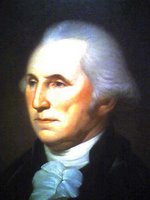 In our travels to the Delaware Art Museum today we saw this portrait of George Washington by Rembrandt Peale. It is interesting to imagine that the portrait was near the father of our country all that time ago.
In our travels to the Delaware Art Museum today we saw this portrait of George Washington by Rembrandt Peale. It is interesting to imagine that the portrait was near the father of our country all that time ago.
 I saw this little box and poster for the Ronald McDonald house to collect and donate soda pop tabs. I said to myself, this can't be real, this is the urban legend where people were convinced to collect pull tabs to exchange for kidney dialysis time. Was I a witness to an urban legend out in the wild? There was a phone number on the poster so I did more investigation.
I saw this little box and poster for the Ronald McDonald house to collect and donate soda pop tabs. I said to myself, this can't be real, this is the urban legend where people were convinced to collect pull tabs to exchange for kidney dialysis time. Was I a witness to an urban legend out in the wild? There was a phone number on the poster so I did more investigation.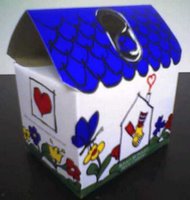 Yes, Ronald McDonald house collects pop tabs for recycle. In my discussions with the local Ronald McDonald house personnel, I asked some questions and found out a few things. Why not recycle the whole can instead of just the tab? They say that the tab has more aluminum in it than the rest of the can. This is not true according to snopes, and common sense.
Yes, Ronald McDonald house collects pop tabs for recycle. In my discussions with the local Ronald McDonald house personnel, I asked some questions and found out a few things. Why not recycle the whole can instead of just the tab? They say that the tab has more aluminum in it than the rest of the can. This is not true according to snopes, and common sense.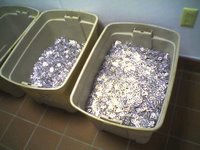 The staff was very nice to me and showed me their tubs and tubs of pull tabs and provided the information above about the program. Still, I can't but help there is a better way for them to raise funds for their cause. Why not recycle the whole can, at 14 grams it weighs more than twenty times what the tab (0.6 grams) weighs. The person who had the tab had the can, it would have been 20 times more money raised. Better still, just collect pennies instead of the tabs. There are 181 pennies in a pound, that's $1.38 extra per pound for the charity.
The staff was very nice to me and showed me their tubs and tubs of pull tabs and provided the information above about the program. Still, I can't but help there is a better way for them to raise funds for their cause. Why not recycle the whole can, at 14 grams it weighs more than twenty times what the tab (0.6 grams) weighs. The person who had the tab had the can, it would have been 20 times more money raised. Better still, just collect pennies instead of the tabs. There are 181 pennies in a pound, that's $1.38 extra per pound for the charity. Add this to the tinfoil hat category (do they work? point, counterpoint). Fred Gilbert, the president of Lakehead University will not allow wi-fi on campus because of his concern that there may be health effects related to exposure to EM fields. He bases his decision on scientific evidence that says there is some potential for health effects, but here are his citations -
Add this to the tinfoil hat category (do they work? point, counterpoint). Fred Gilbert, the president of Lakehead University will not allow wi-fi on campus because of his concern that there may be health effects related to exposure to EM fields. He bases his decision on scientific evidence that says there is some potential for health effects, but here are his citations -"Gilbert cited studies done by scientists for the California Public Utilities Commission, whose findings boil down to the fact that while there is no proven link between EMFs exposure and diseases such as leukemia and brain tumours, the possible risk warrants further investigation."and
"“Even the World Health Organization in its international review says it doesn't have a great deal of concern but it admits the information is not 100 per cent."So no proven link, but let's keep investigating anyway, and base our decisions on this lack of evidence. Are you ready to enroll yourself or send your children to this top notch school run by someone who does not make fact-based, science-supported decisions?
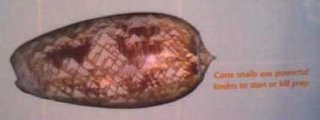 Did you know that the Delaware Museum of Natural History has a top ten collection of mollusks and birds? I am proud of my regional museum. In the rows and rows of mollusk shells on display I ran across this cone snail shell whose triangular patterns immediately reminded me of figures I have seen of cellular automata.
Did you know that the Delaware Museum of Natural History has a top ten collection of mollusks and birds? I am proud of my regional museum. In the rows and rows of mollusk shells on display I ran across this cone snail shell whose triangular patterns immediately reminded me of figures I have seen of cellular automata.
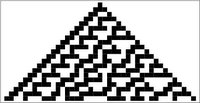 Then you can build a pattern based on these rules. Rule 30 is an interesting one because it has chaotic, interesting behavior.
Then you can build a pattern based on these rules. Rule 30 is an interesting one because it has chaotic, interesting behavior.
 So now compare a closeup of the cone snail shell to the (upside down) results of cellular automata rule 30. Mother nature uses these simple rules, built up by overlapping dynamic chemical reactions, and controlled by biology to put designs on shells, spots on leopards, and stripes on zebras.
So now compare a closeup of the cone snail shell to the (upside down) results of cellular automata rule 30. Mother nature uses these simple rules, built up by overlapping dynamic chemical reactions, and controlled by biology to put designs on shells, spots on leopards, and stripes on zebras. Contrary to what you might think ethno-conchology is not the study of conking people on the head, it is the study of shell money. I learned this on a tour of the Delaware Natural History Museum. The exhibit was full of cowrie shells, which have been used as money by many groups.
Contrary to what you might think ethno-conchology is not the study of conking people on the head, it is the study of shell money. I learned this on a tour of the Delaware Natural History Museum. The exhibit was full of cowrie shells, which have been used as money by many groups.